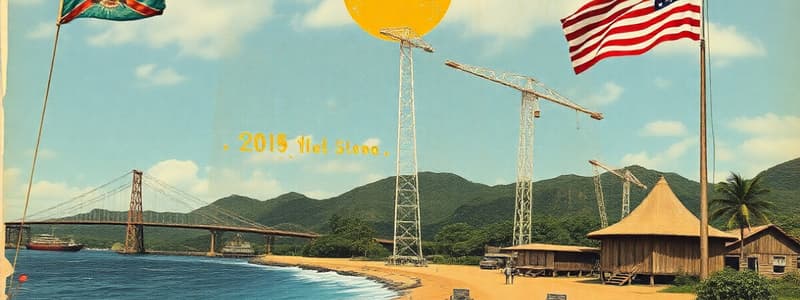Podcast
Questions and Answers
What was the name of the warrior-king who united the Hawaiian Islands?
What was the name of the warrior-king who united the Hawaiian Islands?
Kamehameha the Great
Besides trade, what was the primary interest of Americans and Europeans in Hawaii in the 1820s?
Besides trade, what was the primary interest of Americans and Europeans in Hawaii in the 1820s?
Missionary work or spreading Christianity
What was the primary economic activity that white settlers in Hawaii pursued after initial missionary work?
What was the primary economic activity that white settlers in Hawaii pursued after initial missionary work?
Sugar plantation or sugar industry
How did the Treaty of Reciprocity impact the Hawaiian sugar industry?
How did the Treaty of Reciprocity impact the Hawaiian sugar industry?
What was the name of the group of businessmen and politicians that was also known as the Annexation Club?
What was the name of the group of businessmen and politicians that was also known as the Annexation Club?
What was the name of the constitution that King Kalakaua was forced to sign, and what was its main effect?
What was the name of the constitution that King Kalakaua was forced to sign, and what was its main effect?
Who succeeded King Kalakaua and what action did she attempt to take regarding the Bayonet Constitution?
Who succeeded King Kalakaua and what action did she attempt to take regarding the Bayonet Constitution?
What was the role of the Honolulu Rifles during the overthrow of the Hawaiian monarchy?
What was the role of the Honolulu Rifles during the overthrow of the Hawaiian monarchy?
What was the stated purpose of the US troops landing in Honolulu, and what was their real impact?
What was the stated purpose of the US troops landing in Honolulu, and what was their real impact?
Name two factors that led to native Hawaiians becoming a minority in their own land.
Name two factors that led to native Hawaiians becoming a minority in their own land.
Flashcards
Annexation of Hawaii
Annexation of Hawaii
The annexation of Hawaii by the United States in 1898, marked by political intrigue and economic interests.
Kingdom of Hawaii
Kingdom of Hawaii
The Hawaiian Islands became a sovereign Kingdom under Kamehameha the Great, unifying the various islands by conquest in the late 18th century.
Missionaries' role in Hawaii
Missionaries' role in Hawaii
Christian missionaries, settling in Hawaii, played a key role in spreading Christianity among the native population, but later shifted their focus towards economic interests.
The Annexation Club
The Annexation Club
Signup and view all the flashcards
Treaty of Reciprocity
Treaty of Reciprocity
Signup and view all the flashcards
The Hawaiian League
The Hawaiian League
Signup and view all the flashcards
The Honolulu Rifles
The Honolulu Rifles
Signup and view all the flashcards
The Bayonet Constitution
The Bayonet Constitution
Signup and view all the flashcards
Minority Status of Native Hawaiians
Minority Status of Native Hawaiians
Signup and view all the flashcards
Study Notes
Annexation of Hawaii
- Hawaii was a sovereign kingdom for a century before becoming part of the US.
- The islands were inhabited since at least 1000 AD, uniting in the 19th century under King Kamehameha I. He conquered neighboring islands in 1795.
- American and European interest in Hawaii began in the 1820s, primarily with Christian missionaries, but later shifted towards exploiting the sugar industry.
- Native Hawaiians were a minority in land ownership, wealth, and power by the mid-19th century.
- A significant growth of American influence in Hawaiian political affairs is evident as four of five advisors in the 1845 Hawaiian cabinet were white Americans and a Scot.
US Expansion and Sugar Industry
- US westward expansion coincided with the rise of the Hawaiian sugar industry.
- The Treaty of Reciprocity allowed the US to import Hawaiian sugar tariff-free, boosting exports by over 700% between the treaty's signing and 1890.
- The sugar industry profits did not benefit ordinary Hawaiians, but the monarchy still received a portion.
Formation of the Hawaiian League and the Bayonet Constitution
- In 1887, a group called "the Annexation Club" or "the Hawaiian League," gained control of Hawaiian troops (Honolulu Rifles) and forced King Kalakaua to sign the Bayonet Constitution.
- This constitution stripped the King of most power, giving it to the League members, including Peter C. Jones (head of a large sugar company) and Sanford B. Dole (future Dole Foods founder).
Queen Lili'uokalani and the Coup
- King Kalakaua died in 1891 and was succeeded by his sister, Queen Lili'uokalani.
- She used popular support from Native Hawaiians to try to repeal the Bayonet Constitution; however, the Hawaiian League wanted complete control.
- On January 17, 1893, the Honolulu Rifles and US troops (with US ambassador John Stevens's orchestration for Marines and sailors from USS Boston) assisted in the removal of Queen Lili'uokalani.
- Queen Lili'uokalani surrendered , and a failed rebellion to restore the monarchy followed.
- The Republic of Hawaii was then proclaimed with Dole as president.
US Annexation and Legacy
- Despite President Cleveland's objections on moral grounds, Hawaii was subsequently annexed in 1898.
- Dole became Hawaii's first governor.
- Native Hawaiians protested the annexation and subsequent statehood (1959); leading to a significant minority status of Hawaiians.
Studying That Suits You
Use AI to generate personalized quizzes and flashcards to suit your learning preferences.




